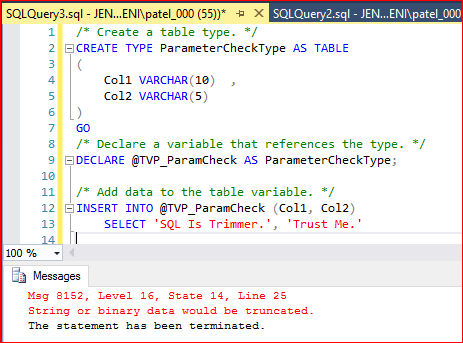Note: This topic applies to Microsoft SQL SERVER 2016.
Microsoft have introduces a support for temporal table (Track historic changes) as a database feature in SQL SERVER 2016 which provides built in support for provide information about data stored in the table at any point in time rather than only the data that is current at the moment of time. Let’s understand what is temporal table? , Why do we need temporal table, how does this temporal table work?
What is Temporal Table?
Temporal table is table for which PERIOD definition exists and it contains system columns called as SysStartTime and SysEndTime with a datatype of datetime2 into which the period of validity recorded by the SQL SERVER, and temporal table has associated history table. This historical table holds all the prior versions of each record with their period of validity and this all has been managed by SQL SERVER internally. With temporal table we can determine value of the record at any point in time rather than just the current value of the each record. A temporal table is called as system-versioned table.
Why do we need temporal table?
Real data sources are dynamic and historical data analysis is often key to business success. We can use temporal table in below cases.
- Time Trend: To understand the business trends over time or Tracking data changes over time.
- Data Audit: Auditing all changes to data.
- Slow Changing dimension, useful for data warehouse load for Type 2 Dimension.
- Repair Record Level corruption: in the event of accidental update/delete you can easily recovered each record from history table.
How does temporal table work?
Implementations of a temporal table involves pair of tables, current table and history table. With each of these tables, two additional datetime (datetime2 datatype) columns are used to defined period of validity for each record – a system start time (SysStartTime) column and a system end time (SysEndTime) column. The current table contains the current value for each record. The historical table contains the each previous value for each record, if any, and the start time and end time for the period for which it was valid.
INSERTS: On an INSERT of a record the system set the value for the SysStartTime column to the UTC time of the current transaction based on the system clock and set the value for the SysEndTime column to the maximum value of 9999-12-31 – this marks the record as open.
UPDATES: On an UPDATE, the system stored the previous value of the record in the history table and sets the value for the SysEndTime column to the UTC time of the current transaction based on the system clock. This marks the record as closed, with a period recorded for which the record was valid. In the current table record is updated with its new value and system sets the value for the SysStartTime column to the UTC time of the current transaction based on the system clock. The value for the updated record in the current table for the SysEndTime column remains the maximum value of 9999-12-31.
DELETES: On a DELETE, the system stored the previous value of the current record in the history table and sets the value for the SysEndTime column to the UTC time of the current transaction based on the system clock. This marks the record as closed with a period recorded for which the previous record was valid. In the current table the record is removed and queries of the current table will not return this value. Only queries that deal with history data return data for which a record is closed.
MERGE: On a MERGE behaves as an INSERT, an UPDATE, or a DELETE based on the condition for each record.
For More information about Temporal Table please follow:
1) https://msdn.microsoft.com/en-us/library/dn935015%28v=sql.130%29.aspx
2) http://channel9.msdn.com/Shows/Data-Exposed/Temporal-in-SQL-Server-2016
Related Post
How to Implement Temporal table on a new table?
Migrate an Existing Solution to Use System Versioing.










